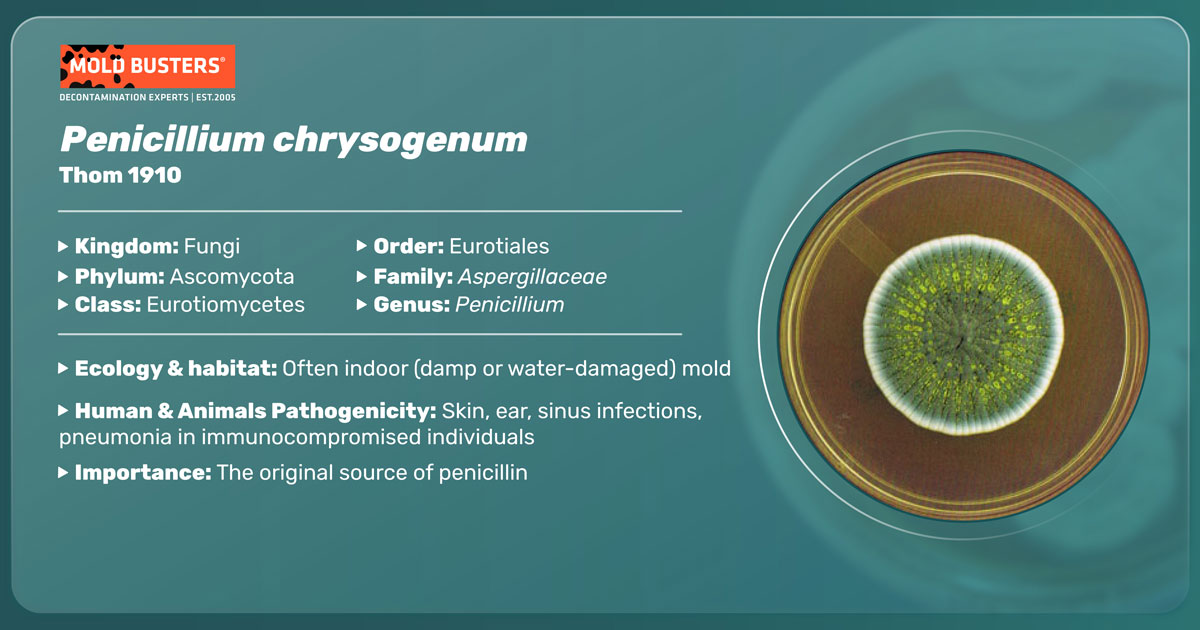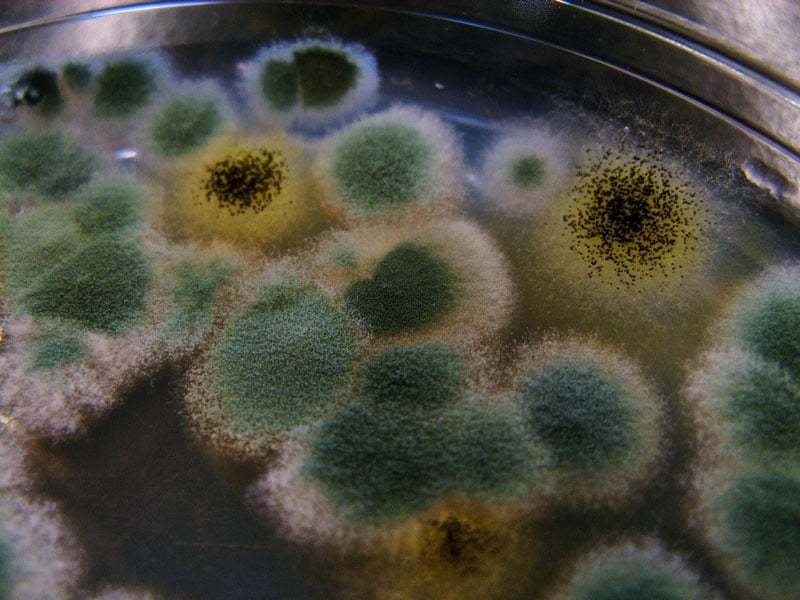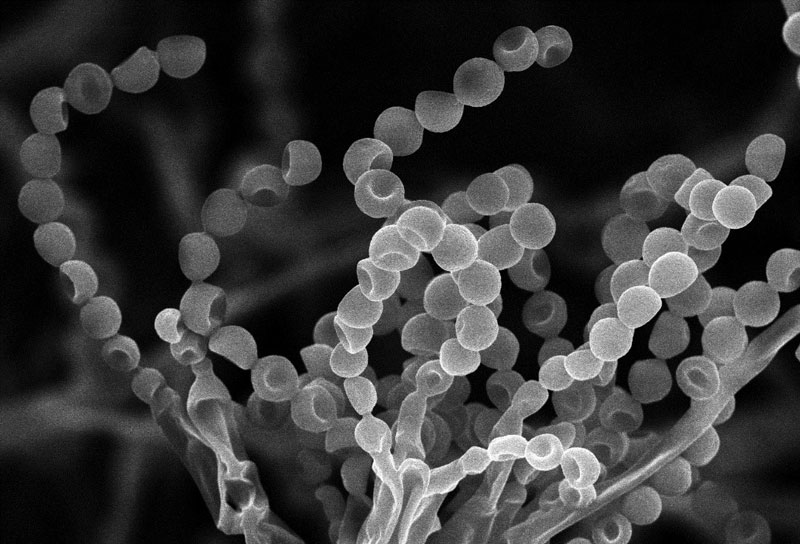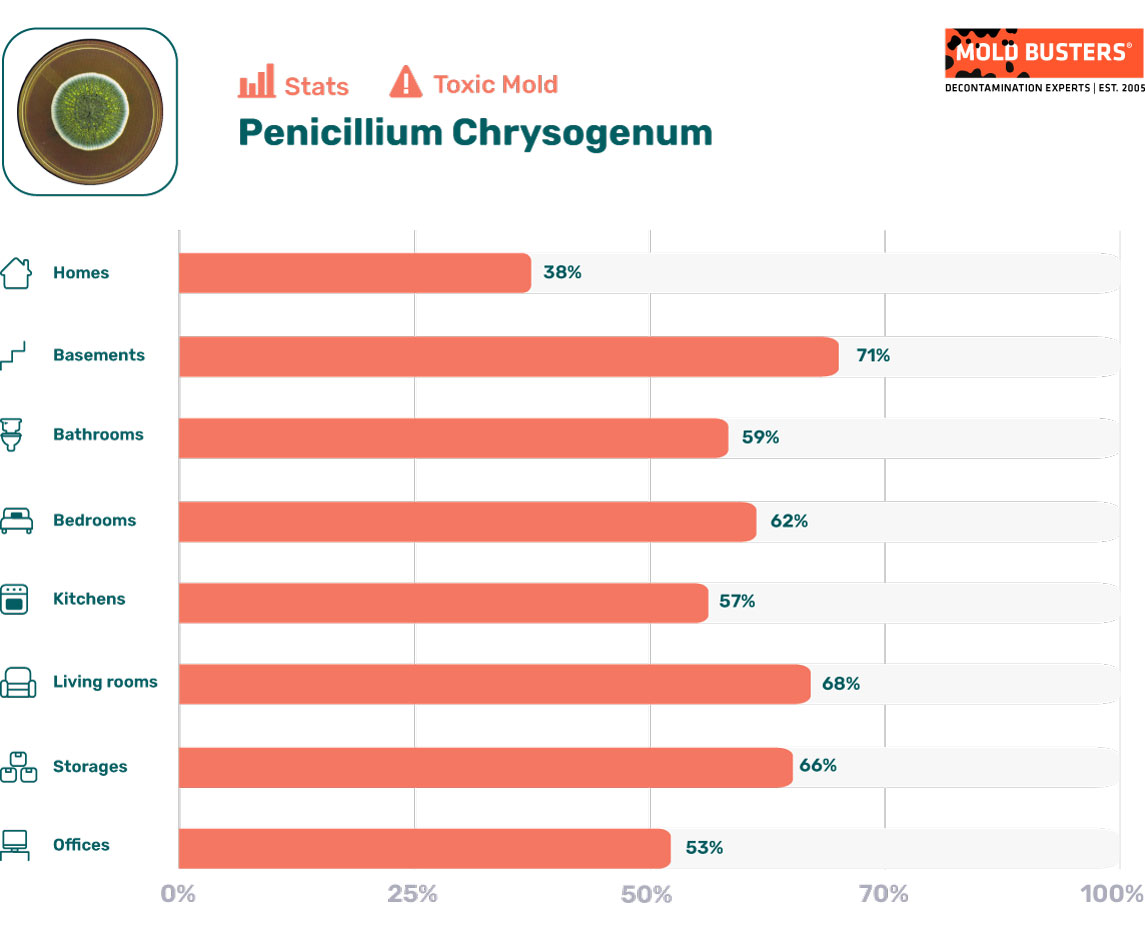Thom 1910
Previously known as Penicillium notatum, P. chrysogenum is a widely studied Penicillium species, most famous for being one of the sources of penicillin and several other antibiotics. P. chrysogenum can most often be found indoors, particularly where there is high humidity, dampness, or water damage. P. chrysogenum colonies are blue-green often with a yellowish pigmentation as well. P. chrysogenum is well-known both as an allergen and as a pathogen, predominantly causing opportunistic infections in people with weakened immune systems due to an underlying disease or therapy.

What is Penicillium chrysogenum?
P. chrysogenum is a widespread mold commonly found in temperate and subtropical regions. It can be found in soil and vegetation. It grows on damp building materials, and is a frequent food contaminant, making it a common indoor fungus [2]. It is also associated with the discovery of penicillin by Sir Alexander Fleming in 1928 [3].
Penicillin is one of the oldest broad-spectrum antibiotics which is used to treat various types of bacterial infections. Although production methods have improved greatly since the initial discovery, commercial strains of P. chrysogenum are still the main source of penicillin and several other β-lactam antibiotics [4].
What are sources of Penicillium chrysogenum?
The entire genus Penicillium received its name from the Latin word “penicillius”, which translates to “painter’s brush”, due to the appearance of its conidiophores. P. chrysogenum can be easily isolated from soil, air, and decaying organic (mostly plant) matter. It is a frequent contaminant of food products, especially cereal such as rice, wheat, barley, maize, and maize-based products. Dried and cured meat products are also a source of P. chrysogenum as it is a xerophilic species, requiring small amounts of moisture in its substrate to grow [11].
Penicillium chrysogenum morphology
Colonies on MEA are app. 25–40 mm in diameter, generally plane-looking, low and velutinous, occasionally centrally tufted or granular. Colonies are greyish turquoise to dull green, sometimes with yellowish color (Fig. 1).

Conidial production is moderate. Conidia are ellipsoidal, 2.5–4.0 µm long, smooth-walled. They are borne in long, irregular columns, forming on brush-like conidiophores (Fig. 2) [11].

Some important facts about Penicillium chrysogenum
Penicillium chrysogenum produces penicillin only when subjected to environmental stress, and only under certain conditions. These conditions such as necessary precursors, temperature and pH are tightly controlled to achieve optimal antibiotic production. One of the important limiting factors in producing penicillin is glucose, which inhibits the biosynthesis. P. chrysogenum can produce penicillin only when glucose has been spent and not during active growth, while lactose promotes the synthesis.
Incidentally, the beginning of mass penicillin production coincided with WWII and the production had to be optimized due to its enormous potential. In 1943, a worldwide search was organized for finding high penicillin-producing strain of P. chrysogenum. The most prolific strain was obtained from a moldy cantaloupe found at a market in Peoria, Illinois [5]. After years of selection and modification, today’s strains produce 40-50g of penicillin per liter of culture compared to 0.15g per liter from the cantaloupe strain [4].
During the mid-20th century, the chemical structure of penicillin was discovered and the structure at its core, 6-aminopenicillanic acid (6-APA), was isolated. This allowed for the development of semisynthetic penicillins, which improved various aspects of the drug, including its spectrum of activity, stability and tolerance.
What are Penicillium chrysogenum growth conditions?
Penicillium chrysogenum is a mesophilic species, needing a minimum growth temperature of 4°C (118°F), with an optimum at 23°C (73.4°F) and a maximum at 37°C (98.6°F). P. chrysogenum is also among the most xerophilic Penicillium species, observed to germinate at 0.78 aw (water activity of the growth medium). Its optimal pH ranges between 4–6.
Penicillium chrysogenum mold statistics
As part of the data analysis presented inside our mold statistics resource page, we have calculated how often mold spore types appear in different parts of the indoor environment when mold levels are elevated. Below are the stats for Penicillium chrysogenum:


What disease does Penicillium chrysogenum cause?
With only a handful of reports of side effects and diseases, Penicillium species are generally considered to be safe. However, P. chrysogenum has been known to cause opportunistic infections. Aside from low-level mycoses such as skin rashes and ear infections (otomycosis), P. chrysogenum has been known to have caused sinusitis, posttraumatic endophthalmitis, necrotizing esophagitis [1], necrotizing pneumonia [7], intestinal invasion, and disseminated disease [8].
What allergies are related o Penicillium chrysogenum?
Like most molds, P. chrysogenum reproduces by airborne asexual spores (conidia), which have allergenic properties [9]. These spores are ubiquitous in the air around us and we inhale several thousand daily. Although this does not affect most people, sensitive individuals may experience adverse effects. They could suffer from breathing-related problems, skin allergies, constant sneezing, and red/watery eyes. Another type of allergy-related to P. chrysogenum is the well-documented allergy to penicillin, with approximately 10% of people having this condition.
How to get rid of Penicillium chrysogenum mold?
If you come across growths of P. chrysogenum mold, you must take steps to get rid of it immediately. The first task is to spray the growth with water. This will reduce the number of spores that are released into the air when the cleaning process is undertaken. A damp cloth should be used to clean the walls and other surfaces where the mold has developed. Finally, you should clean the entire area with a combination of one gallon of warm water mixed with half a cup of household bleach. This should kill the fungus quite thoroughly.
If the problem persists, your best bet is to contact a professional mold remediation company like Mold Busters. We offer comprehensive mold testing services that include surface sampling (tape/swab/bulk) and air sampling (viable/non-viable). We have 19 years of experience in removing mold and will be able to rid your house of mold once and for all. Call us today to book an appointment.
References
- Howard DH (2003). Pathogenic Fungi in Humans and Animals. Marcel Dekker, New York. pp 329-333.
- Andersen B, Frisvad JC, Søndergaard I, Rasmussen IS, Larsen LS (2011). Associations between fungal species and water-damaged building materials. Applied and Environmental Microbiology. 77 (12): 4180–8.
- Fleming A (1929). On the Antibacterial Action of Cultures of a Penicillium, with Special Reference to their Use in the Isolation of B. influenzæ. Br J Exp Pathol. 10(3): 226–236.
- Meštrović T (2018). Penicillin production. Retrieved from news-medical.net.
- Bellis M (2018). The History of Penicillin. Retrieved from thougtco.com.
- Pitt JI, Hocking AD (2009). Fungi and Food Spoilage. Springer, New York. pp. 236-237
- D’Antonio D, Violante B, Farina C, Sacco R, Angelucci D, Masciulli M, Iacone A, Romano F (1997). Necrotizing pneumonia caused by Penicillium chrysogenum. J Clin Microbiol. 35(12):3335-7.
- Barcus AL, Burdette SD, Herchline TE (2005). Intestinal invasion and disseminated disease associated with Penicillium chrysogenum. Ann Clin Microbiol Antimicrob. 4:21.
- Shen HD, Chou H, Tam MF, Chang CY, Lai HY, Wang SR (2003). Molecular and immunological characterization of Pen ch 18, the vacuolar serine protease major allergen of Penicillium chrysogenum. Allergy. 58(10):993-1002.
- Pongdee T (2019). Penicillin allergy – what do you need to know? Retrieved from aaaai.org.
- Pitt, J. I., & Hocking, A. D. (2009). The ecology of fungal food spoilage. In Fungi and food spoilage (pp. 3-9). Springer, Boston, MA.

Get Special Gift: Industry-Standard Mold Removal Guidelines
Download the industry-standard guidelines that Mold Busters use in their own mold removal services, including news, tips and special offers:

Written by:
John Ward
Account Executive
Mold Busters
Edited by:
Dusan Sadikovic
Mycologist – MSc, PhD
Mold Busters
